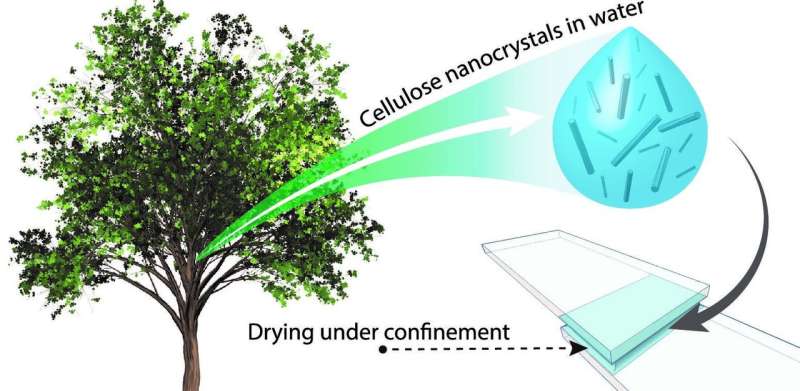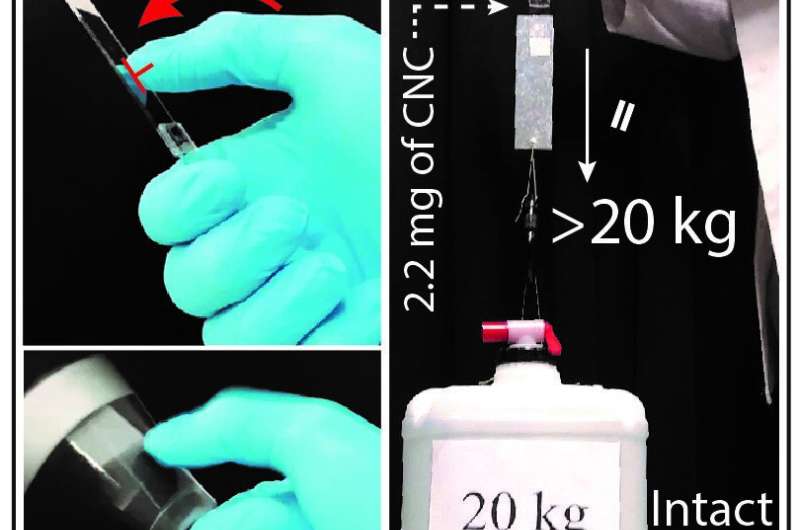basic demonstration graphic. Credit: Aalto University
In a study published in Advanced Materials, researchers at Aalto University, the University of Tokyo, Sichuan University and the University of British Columbia have demonstrated that plant-derived cellulose nanocrystals (CNCs) can form an adhesive that fully integrates the concepts of sustainability, performance and cost, which are generally extremely challenging to achieve simultaneously.
Unlike superglue, the new eco-glue develops its full strength in a preferred direction, similar to "peel and stick" adhesives. When trying to separate the glued components along the principal plane of the bond, the strength is more than 70 times higher when compared to the direction perpendicular to that plane. All of this means that just a single drop of the eco-glue has enough strength to hold up to 90 kg weight, but can still be easily removed by the touch of a finger, as needed. As Dr. Blaise Tardy from the Aalto Department of Bioproducts and Biosystems puts it, "The ability to hold this amount of weight with just a few drops is huge, especially from a natural plant-based solution."
These kind of properties are useful in protecting fragile components in machines that can undergo sudden physical shock such as high-value components in microelectronics, to increase the reusability of valuable structural and decorative elements, in new solutions for packaging applications, and—in general—for the development of greener adhesive solutions.
Luiz Greca (72kgs heavy) tests the platform that has lateral supports bonded with the adhesive. Credit: Aalto University
Furthermore, compared to the current approach of making high-strength glues that can involve complex and expensive routes, the team reports that their solution simply takes bio-based particle sources from plants (with a comparatively negligible cost) and adds water. Since curing time is associated with evaporation of the water phase (~2 hours, currently), it can be controlled with heat.
Aalto Professor Orlando Rojas says, "Reaching a deep understanding of how the cellulose nanoparticles, mixed with water, form such an outstanding adhesive is a result of the work between myself, Dr. Tardy, Luiz Greca, Professor Hirotaka Ejima, Dr. Joseph J. Richardson and Professor Junling Guo, and it highlights the fantastic collaboration and integration of knowledge toward the development of an extremely appealing, low-cost and safe application."
Credit: Aalto University
"Good, green packaging with bad glue still renders the packaging bad," says Dr. Blaise Tardy.Moreover, the prospects for worldwide utilization (in a 40B€ industry) is quite attractive given the ever-increasing production of cellulose nanocrystals seen across the globe, as supported by incentives in the framework of the circular bioeconomy.
Dr. Blaise Tardy says, "Good, green packaging with bad glue still renders the packaging bad. The truly exciting aspect of this is that although our new adhesive can be sourced directly from residual biomass, such as that from the agro-industry or recycled paper, it outperforms currently available commercial synthetic products by a great many measures."
More information: Blaise L. Tardy et al, Exploiting Supramolecular Interactions from Polymeric Colloids for Strong Anisotropic Adhesion between Solid Surfaces, Advanced Materials (2020). DOI: 10.1002/adma.201906886
Journal information: Advanced Materials
Provided by Aalto University

























